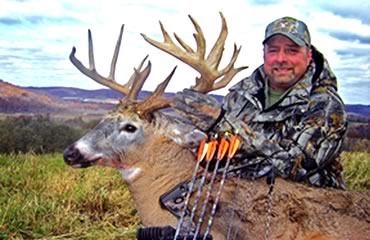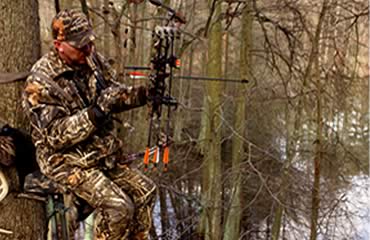When the hunting gets slow, it might be time to break a few “rules.”
On Oct. 23, 2006, Wisconsin hunter Barry Rose hoped to meet up with the buck he’d seen earlier in the season. The 16-point typical monster, with antlers measuring 208 1/8 inches, was well worthy of any hunter’s attention.
On the way in to the stand that overlooked the pine thicket, Rose hung a film canister filled with doe estrus. Then he performed his ritual of a light rattling sequence to cover his tracks. Time passed uneventfully for the next hour.
“At 6 a.m., I started my third rattling sequence,” Rose explained. “About 5 minutes later, I spotted a body moving through the thick stuff. When the deer hit an opening, I saw its rack and knew it was him!
“The next time I saw the buck, he was leaving and wasn’t going to give me a shot. Luckily, he smelled the estrus, turned and came in on a string. Once he reached the canister, he really put on a show. Standing 20 yards in front of me, this incredible buck inhaled this scent and raked his antlers on the branch! He was totally captivated.”
Although the buck stood less than 20 yards away, the angle didn’t allow for a shot. Finally, after several minutes of working the scent, the bruiser sensed something wasn’t right. Turning toward where he’d come from, he began to walk away. As he entered the shooting lane, Barry came to full draw and let the arrow fly.
Not only had Rose just shot a buck of a lifetime, he did it toward the tail end of the dreaded October lull. Even during this time, when nothing seems to move in the woods, mature bucks can be had — if you develop your tactics accordingly.
Bedding-Area Scare Tactics
As was the case with the Rose buck, one way to score during the October and post-rut lull phases is to hunt the doorsteps of bedding areas. The first step is to break from the mindset that hunting these sacred grounds is taboo.
Since the first time I picked up a bow, I can’t tell you how many times I’ve been warned of the dangers of hunting in and around bedding areas. Because of the ingrained fear those warnings caused, I missed out on many great stand sites.
There’s some merit to the caution of bedding-area naysayers; this is where deer tolerate the least amount of disturbance. However, my experience has taught me that bumping a buck from his bed doesn’t have to be the kiss of death. When scouting, I’m thrilled to see a magnificent buck exiting his bedroom; it removes the guesswork. And I don’t believe that one encounter with humans signifies impending doom. The key is not to make it a habit or leave signs of a more permanent invasion.
 Beating the Blues
Beating the Blues
The most productive times to hunt bedding areas are when nowhere else is producing. The lull phases that occur between the first couple weeks of season and the peak scraping phase, as well as the first few weeks after bucks stop actively seeking does, are good examples. Bucks keep their daylight movement to a minimum during these lulls, and that makes hunting near beds the only way to catch daylight activity.
To be successful, get as close to a buck’s bed as possible without alerting him to your presence. The closer you get, the higher the likelihood of catching him on the way to his evening food source. On the flip side, if he picks you up getting to your stand, there is no way you’ll get a shot. The key is to find that delicate balance.
A buck I took early in the 2003 archery season illustrates how this tactic can pay off. Having hung a stand bordering a cornfield bedding area in midsummer, I left it alone until the October lull kicked in. About 40 minutes after getting settled in the stand for the first sit, I heard the distinctive low snap of a branch. Next I saw a buck slipping down the trail and noticed a 4-inch P2.
I snatched up my bow, drew and held my breath. Having placed a dripping scent wick in my shooting window, I banked on it to bring the buck to a stop. It did its job. With his nose glued to the scent wick, I had plenty of time to focus and slipped an arrow neatly behind his shoulder. Several bounds and one loud crash later, the buck was mine.
In addition to lull phases, this tactic is productive any time bucks have adopted nocturnal lifestyles. Heavy hunting pressure, harsh weather and unseasonably high temperatures can shut down most daylight activity. When that happens, set up an ambush that overlooks the buck’s bedroom door.
Peeking in the Girls’ Bedroom
Mature bucks don’t normally bed right with the does, but hunting family-group bedding areas can still pay off. Bucks are driven by two primary forces in life: eating and breeding. While hunters try to make the breeding phase fit into a neat little time slot, bucks think about breeding a lot more than just two weeks of the year. Sometimes you can catch them taking a peek in the girls’ bedroom to see what’s happening.
 This curiosity is about the only thing that makes them vulnerable, and I believe that the lull phases are the best times to target a specific world-class buck. Bucks work hard to find willing partners, which are few and far between during the lulls.
This curiosity is about the only thing that makes them vulnerable, and I believe that the lull phases are the best times to target a specific world-class buck. Bucks work hard to find willing partners, which are few and far between during the lulls.
Add all that up, and the idea of Mr. Big cruising family-group bedding areas during the lulls makes sense. With one downwind pass, he can determine if an estrous doe is waiting inside. Because of this, set up your stand on the downwind side of family bedding areas. Look for primary scrapes and try using estrous scents.
One thing to keep in mind is that I’m talking about mature bruiser bucks. Hunting properties holding only 2 1/2-, 3 1/2- and even the more submissive 4 1/2-year-old bucks will be less likely to achieve great results through hunting does during the lulls. The younger bucks tend to be more content to wait for the peak of the rut to do their bedroom searches.
A Notable Exception
I have consistently found bedding areas to be the key to beating the lull, but don’t overlook remote food sources. The keys to a food source paying off during a lull period are the illusion of safety and lack of hunting pressure.
Crash the Bedroom
We already talked about the high-risk factor of hunting near bedding areas; hunting inside them takes that to a new level. Don’t employ this tactic unless all else fails.
First, unlike hunting the edge, you have to be willing to be there before the deer return. When plunging into a buck’s bedroom, you better get in there at least two hours before first light, and pushing it to three hours isn’t a bad idea.
Next, there’s the challenge of staying undetected. Early morning thermals can lift our odors above our prey’s nose, but getting in early puts that much more scent in the air. The fact that deer are often camped out nearby makes a brief shift in wind direction even more dangerous than usual.
Finally, you must be prepared for an all-day sit, which wears on the mind and body, especially during a lull. When hunting bedding areas, you don’t always have the option of slipping out undetected. If you leave the area before the deer do, chances are you’ll blow your cover and ruin the stand site.
If I’ve made hunting near bedding areas sound difficult, then I’ve done my job. All of these factors add to the challenge, but the rewards can make it worthwhile.
To reap these rewards, pay particular attention to stand placement. The buck likely will bed well before first light. Ideally, you can remain undetected and, once shooting light arrives, take the buck in his bed. Often, though, because of the buck’s angle or inconveniently positioned branches, that isn’t possible. Under those conditions, you have no choice but to wait him out until he rises to relieve himself. If the stand isn’t within shooting range, odds are slim that you’ll ever get a shot.
Conclusion
As with most myths, there’s a grain of truth to why hunters should stay away from bedding areas. If we crash them once too often, it can have harmful effects on our hunting. However, if we keep our disturbances to a minimum, select good routes to our stands and play the wind, bedding areas can be great locations to beat the lull and drag out a monster buck.
Editor’s Note: Check out Steve Bartylla’s books: Advanced Stand Hunting Strategies ($22.50) and Bowhunting Tactics That Deliver Trophies ($30). For personally autographed copies of either or both ($50 when ordered together), send a check or money order to: Steve Bartylla, 1406 Saint Joseph Ave., Marshfield, WI 54449.
This article was published in the October 2007 edition of Buckmasters Whitetail Magazine. Join today to have Buckmasters delivered to your home.